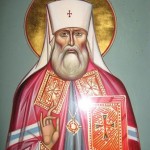Deprecated: trim(): Passing null to parameter #1 ($string) of type string is deprecated in /home/aoiusa/public_html/wp-content/plugins/sexybookmarks/public.php on line 388
Deprecated: trim(): Passing null to parameter #1 ($string) of type string is deprecated in /home/aoiusa/public_html/wp-content/plugins/sexybookmarks/public.php on line 394
Deprecated: trim(): Passing null to parameter #1 ($string) of type string is deprecated in /home/aoiusa/public_html/wp-content/plugins/sexybookmarks/public.php on line 400
On the Get Relgion blog, Terry Mattingly describes a trip he made to Kiev to speak to Ukrainian journalists “about the challenges of covering religion news in mainstream press.” He looks at the divisions among Orthodox Churches in the Ukraine, which is set against the long running antagonisms that exist between that country and Russia. “You see, right now almost anything can create tensions between Ukraine and Russia,” Mattingly writes. “A ceremony with clergy linked to Moscow would create tensions in some circles. A ceremony without clergy linked to Moscow would create tensions in others. The symbolism has political content either way.” He also writes about his trip to Kiev for his Scripps News column. Here’s how he begins:
Merely saying the forest’s name — Bykivnya — can cause strong emotions for millions of Ukrainians.
This is where the secret police of Soviet strongman Joseph Stalin buried 100,000 of their victims between 1937 and 1941 in a mass grave northeast of Kiev. President Victor Yushchenko did not mince words during his recent speech there, on Ukraine’s Day of Remembrance for Victims of Political Repression.
“Here, at Bykivnya, Stalin and his monstrous hangmen killed the bloom of Ukraine. There is no forgiveness and there will be none,” he told several thousand mourners and, of course, Ukrainian journalists.
The mourners wept, while processing through the site behind Orthodox clergy who carried liturgical banners containing iconic images of Jesus and Mary.
“Because of the national symbolism of this ceremony, the priests there may not be important,” said Victor Yelensky, a sociologist of religion associated with the Ukrainian National Academy of Sciences.
“But the priests have to be there because this is Ukraine and this is a ceremony that is about a great tragedy in the history of Ukraine.
“So the priests are there. It is part … of a civil religion.”
This is where the story gets complicated. In the Ukrainian media, photographs and video images showed the clergy, with their dramatic banners and colorful vestments. However, in their reporting, journalists never mentioned what the clergy said or did.
Mainstream media reports also failed to mention which Orthodoxy body or bodies were represented. This is an important gap, because of the tense and complicated nature of the religious marketplace in this historically Eastern Orthodox culture.
It would have been big news, for example, if clergy from the giant Ukrainian Orthodox Church (Moscow Patriarchate) — with direct ties to Moscow — had taken part in a ceremony that featured Yushchenko, who, as usual, aimed angry words to the north.
But what if the clergy were exclusively from the Ukrainian Orthodox Church (Kiev Patriarchate), born after the Soviet Union’s collapse in 1991 and linked to declarations of Ukrainian independence? What if there were also clergy from a third body, the Ukrainian Autocephalous Orthodox Church, born early in the 20th century?
A rite featuring clergy from one or both of these newer churches also would have been symbolic. After all, these days almost anything can create tensions between Ukraine and Russia, from natural gas prices to efforts to emphasize the Ukrainian language, from exhibits of uniquely Ukrainian art to decisions about which statues are torn down (almost anything Soviet) or which statues are erected (such as one of Ivan Mazepa, labeled a traitor by Russia after his 18th century efforts to boost Ukrainian independence).
Read “Eastern Orthodox Church in Ukraine rent by divisions” on the Scripps News site.
